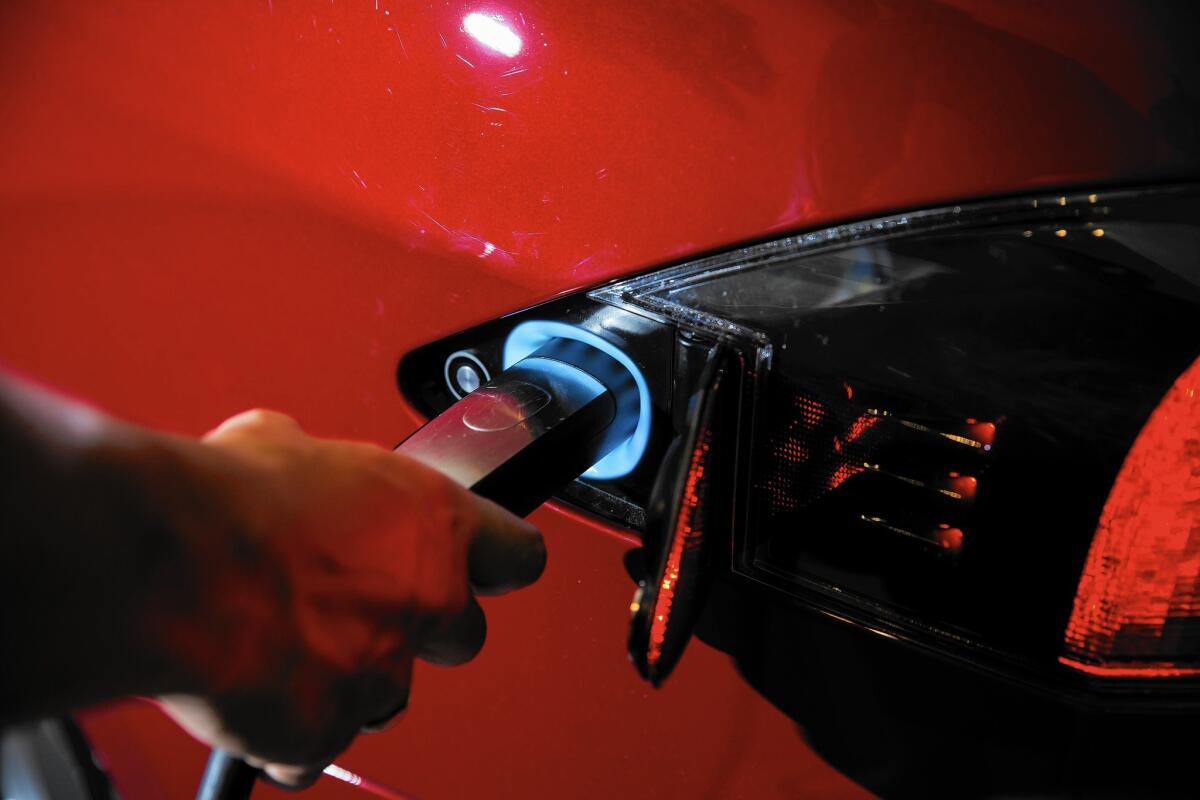California limits hybrid rebates to households earning less than $500,000

A Tesla Model S being charged in a Santa Monica showroom. The entry-level Tesla model starts at about $75,000.
- Share via
in sacramento — SACRAMENTO — Hundreds of Californians with household incomes of $500,000 or more have collected state subsidies for buying electric and hybrid cars under a program that is criticized as a taxpayer handout to the wealthy.
State regulators, in response, are restricting the subsidies to Californians who earn less than $250,000 or couples taking in less than $500,000. But that standard is also under fire from some lawmakers and anti-tax activists, who ask why subsidies worth up to $5,000 are given to people who can already afford the cars.
“The state should not be diverting … taxes on low-income and middle-class families to benefit wealthy drivers,” said Senate Republican leader Bob Huff of San Dimas.
Money for the subsidies comes from a surcharge on vehicle registration fees and a portion of the smog fee paid by California motorists. There were no income limits for the subsidy when the program was enacted in 2010.
The average household income in California is just over $60,000, noted Kris Vosburgh, executive director of the Howard Jarvis Taxpayers Assn. Subsidies for residents who make $250,000, he said, amount to “welfare for the rich” and “a slap in the face to average Californians.”
“Clean” cars typically cost more than those that run on gasoline. State authorities say they are trying to find the right balance between providing an incentive for the growth of the electric car industry and helping low- and moderate-income drivers buy the vehicles.
“Our policy objective here is to rapidly increase the percentage of zero-emission vehicles in the state,” said Mary Nichols, chairwoman of the California Air Resources Board, which oversees the state’s Clean Vehicle Rebate Program.
Since its start, the program has provided $242 million in rebates to 114,702 people who bought or leased electric or hybrid cars.
Data from the Center for Sustainable Energy, which runs the program on behalf of the Air Resources Board, shows that 7,056 people who live in economically disadvantaged census tracts have received a subsidy. Combined, they collected $14.8 million, less than 6% of the total disbursed.
A survey of 15,432 rebate recipients who were willing to report their income ranges, also conducted by the center, found that as of May, 959, or 6% of those Californians, had household incomes of $500,000 or more. About 28% made between $200,000 and $499,000, and 43% earned $100,000 to $199,999.
About 23% reported an income of $99,000 or less.
About 15% of those surveyed said they bought a Tesla. The price of an entry-level electric Tesla Model S starts at about $75,000 before rebates. The manufacturer’s suggested retail price for an electric Nissan Leaf is $29,100 before any rebates.
“There are a good number of people for whom the rebates were not the driver of that purchase,” said Michelle Kinman, an advocate for Environment California, part of a coalition that supports the program to help people who cannot afford a clean vehicle. “They would have made the purchase without the rebates.”
Last year, state Sen. Kevin de León (D-Los Angeles), now the state Senate leader, had legislation signed into law by the governor that directs the state to put 1 million low- and zero-emission vehicles on California roads by 2023.
It also directed the Air Resources Board to set eligibility caps based on income and to provide higher subsidies for low- and moderate-income communities and consumers.
The board recently agreed to increase the size of subsidies available to low-income residents, but the money must still be approved by the Legislature and is not expected to take effect for four to six months.
The board also recently voted to disqualify households earning $500,000 or more from subsidies for battery-operated electric cars. It maintained the aid for those making more than $500,000 for hydrogen fuel cell cars because consumers may need extra incentives to buy them, Nichols said. The change will take place by early next year.
“Certainly there were claims being made that it was a program that was only benefiting the ‘rich’ in California,” said Nichols, whose 12-member board is appointed by the governor. “We want it to be a much broader-based program than that.”
The environmental coalition argued unsuccessfully to set the cap at $400,000 across the board.
Asked about the criticism that subsidies would still go to buyers who earn more than most Californians, Nichols said couples with high incomes “could qualify, but someone like [billionaire] Bill Gates would not. Super-rich people would not.”
The $500,000 line “seemed to exclude people who by anybody’s definition in California are rich,” Nichols added.
She said the auto industry opposed lower caps.
“The real beneficiary of this, in a sense, is the manufacturers, because they are able to sell cars that otherwise they might have to subsidize themselves under our [clean-air] mandate,” she said.
The Alliance of Automobile Manufacturers did not take a position on the legislation but supported the caps set by the air board, according to spokesman Wade Newton.
Claire Conlon, a spokeswoman for De León, said the income cap reflects his intention to promote equity and cost effectiveness and to put more clean cars on the roads more quickly.
“To clean our dirty air, we need these vehicles deployed as broadly as possible to jump-start the market,” Conlon said. “As the technology becomes more affordable, the income cap for the rebates will go down.”
Twitter: @mcgreevy99
ALSO:
Wildfire forces evacuations in Big Bear
Crash on 405 in Van Nuys kills two people and injures more
Americans say train attacker ‘was ready to fight to the end. So were we.’
More to Read
Sign up for Essential California
The most important California stories and recommendations in your inbox every morning.
You may occasionally receive promotional content from the Los Angeles Times.











